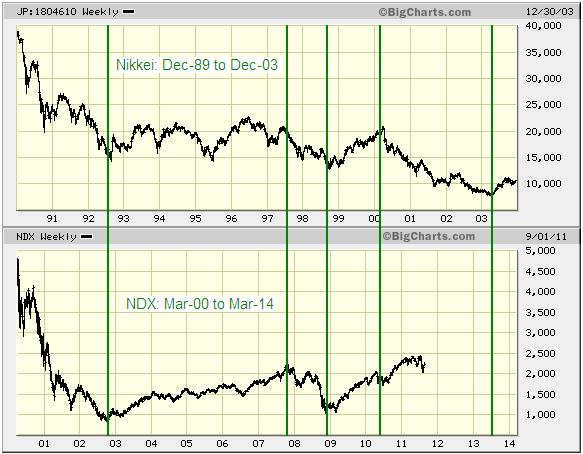The Nikkei Model and Monetary Inflation
Steve Saville
email: sas888_hk@yahoo.com
Posted Sep 13, 2011
Below is an excerpt from a commentary originally posted at www.speculative-investor.com on 4th September 2011.
We usually update our "Nikkei Model" once or twice per year. The most recent update was in February of this year, when we wrote:
"[The Nikkei Model] is based on the idea that the secular bear market in the NASDAQ100 Index (NDX) that began in March of 2000 is generally tracking the secular bear market in Japan's Nikkei225 Index that began in December of 1989. The following chart shows that the most important low points of the Nikkei Model have lined up very well with the NDX's most important low points, but that large divergences have occurred between these turning points. In other words, the NDX has sometimes moved a considerable distance from the Nikkei Model, but up until now it has always worked its way back into line with the Model by the time of the next major low.
The next major low is due in the second half of 2013."

Based on the average duration of secular bear markets in equities, it is reasonable to expect that the NDX's secular bear market will end within 12 months of the time predicted by the Nikkei Model. However, it is clear that the post-bubble NDX has more of an upside bias than the post-bubble Nikkei. This is the result of the US' rate of monetary inflation being much higher than Japan's rate of monetary inflation.
Japan had average money-supply growth of around 2% per year during the 11 years following the bursting of the Nikkei bubble, which led to the Yen maintaining its purchasing power. This compares to the average US money-supply growth rate of around 9% per year during the 11 years since the bursting of the NDX bubble. As a result of the large increase in its supply, today's US$ is worth a lot less than the March-2000 US$.
A likely consequence of dollar depreciation is that the secular bear market in US equities will end with the NDX handily above its 2002 and 2008 lows in nominal dollar terms.
On a related matter, it would be difficult to overstate the importance of money-supply growth. For one, the creation of money out of thin air is the basis for the boom/bust cycle. Or, to put it another way, there would be no debilitating boom/bust cycle without the laws that firstly allow banks and/or governments to create money out of nothing and secondly make the created-out-of-nothing money legal tender. For another, in the absence of money-supply growth there would never be a long-term upward trend in the broad stock market. Individual stocks and stock-market sectors could experience secular bull markets, but the stock market, as a whole, could not. The reason is that in the absence of an expanding supply of money, a secular upward trend in the broad stock market would require the sum total of corporate profits to be an ever-increasing percentage of the overall economy. This, of course, would be impossible.
###
Steve Saville
 email: sas888_hk@yahoo.com email: sas888_hk@yahoo.com
Hong Kong Regular financial market forecasts and analyses are provided at our web site:
http://www.speculative-investor.com/new/index.html. We aren't offering a free trial subscription at this time, but free samples of our work (excerpts from our regular commentaries) can be viewed at: http://tsi-blog.com
Copyright ©2002-2019 speculative-investor.com All Rights Reserved. Saville Archives
321gold Ltd

|

